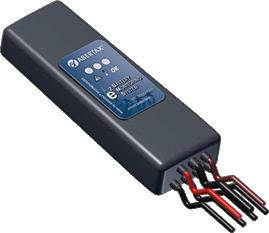
35 minute read
BCI INNOVATION AWARD NOMINATIONS OVER THE YEARS
Abertax
Ever inventive, ever attentive to detail
Abertax has been nominated three times in the awards for a wide variety of submissions.
In 2019 the company patented an innovation aiming to give the optimal charging regime, involving Abertax Battery Management Systems (e2BMS).
It was designed to identify wirelessly which battery, from a number of batteries, has been connected to a charger, and also gather relevant battery data allowing it to programme the most efficient and economic charging profile possible as well as extending the battery lifetime.
It was developed in collaboration between the R&D team at Abertax with charger manufacturer Industrie Elektronik Brilon in Germany.
“Having a battery communicating with its charger to provide the required data to charge it at the right charging profile will have a huge impact on the lifetime and battery performance besides saving time and energy,” the company said.
In 2018 the firm applied for the BCI Innovation Award on the basis of the one-valve battery lid for VRLA batteries, which it says will mean a more reliable and better performing lead acid battery.
Abertax developed a valve with extreme low opening pressure tolerances of +/-25mbar. (The standard is more than +/-50mbar.) However, different opening pressures result in different gassing rates and water loss and leads to premature failure. This new lid design guarantees the same pressure in each cell.
The firm believes this design will eventually be used in all VRLA batteries. It will also mean cost savings, making it even more appealing to manufacturers.
In 2016 Abertax displayed a new patented gel filling process for use in PzV and OPzV cells, which could make the manufacturing process cleaner, safer and cheaper while improving the quality of the batteries.
One of the reasons for gel batteries having a slightly higher price than AGM has been the cumbersome process associated with their filling, formation and finishing processes, and this alleviates some of the problems.
In 2018 the firm applied for the BCI Innovation Award on the basis of the one-valve battery lid for VRLA batteries
2019: Battery Monitoring System – ABERTAX® e2 BMS
Gel transport tubes
Dead end plug Filling plugs

OPzV cells Pump
Valve Gel mixing tank
In 2016 Abertax displayed a new patented gel filling process
Acid tank
Advanced Battery Concepts
The joys of bipolar batteries
Advanced Battery Concepts is one of two firms pushing the boundaries of bipolar batteries. In 2016 it won an honourable mention from the BCI judges and it returned the following year showing improvements in its GreenSeal technology.
This was a suite of patented technologies and simplified production processes, to enable the construction of reduced lead content, high performance, lower cost lead batteries in existing formats for today’s and newly enabled future markets.
Advanced Battery Concepts said at the time it was close to full scale production and a global roll out of its bipolar technology. Seven battery firms have subsequently joined ABC as licensees.
The battery industry has always recognized that if a bi-polar lead acid battery could be manufactured successfully it would have significant advantages for the battery manufacturer and the end user.
“Bi-polar battery designs eliminate grids and top lead and utilize the active chemistry far more efficiently thereby reducing the lead content for the same energy. They would be cheaper to make, smaller and lighter, better for the environment, have a faster recharge rate and greater cycle life,” the firm says.
“To be successful a bi-polar battery needs to be commercially scalable, recyclable and robust. We have concentrated our business focus on simplifying materials, product designs and manufacturing processes and are taking bi-polar lead acid batteries to a new level at ABC.”
Previous attempts at making a commercially viable bi-polar battery at scale have met with limited success because of a number of problems, including the inability to seal between cells and failure to seal to the external environment,
Continued on page 48
ABC: Continued from page 46
the use of costly exotic materials to overcome corrosion and conductivity issues, the requirement for an external strengthening structure to provide uniform AGM compression and to overcome cycling stresses which ultimately result in poor performance in terms of energy and power density, cycle life and cost.
“ABC’s batteries are lighter and cheaper than equivalent batteries in the market today and our partners are really achieving the results we’ve claimed. We have made things simpler and the performance is better,” says the firm.
One of the biggest breakthroughs in the design is that it reduces the lead content in the battery by some 45%.
“That reduction, which is attributable to the bi-polar design, means a significant reduction in the battery manufactured costs,” Hobday says.
The company has also achieved a higher energy density (50 Wh/kg with a path to > 60 Wh/kg — this compares with 35Wh/kg for the best in class AGM batteries today. It has also achieved higher power — >1000 W/kg while maintaining high energy (>40 Wh/kg), a faster recharge of 1.4x faster, a cycle life of three to six times the current VRLA battery life with the potential for more than 10 times, and all at a lower cost.

In 2016 Abertax it won an honourable mention from the BCI judges Modifications to the 2013 prototype (left) resulted in the commercially replicable version.
Aqua Metals Recycling without the smelting
Aqua Metals received an honourable mention in the 2017 awards. Aqua has developed a lead battery recycling process that it calls AquaRefining as an alternative to high temperature smelting of a molten lead.
AquaRefining, the firm says, is a more efficient, less expensive way to build and produce a higher quality product. AquaRefining is a form of electro-winning.
As a liquid-based room temperature process using methyl sulfonic acid it eliminates the processes which produce lead-containing dust, sulfur dioxide and other emissions that are inherent to smelting. This, the firm says, makes environmental compliance simpler and less expensive.
Aqua Metals had intended to bring the technology to market first by building and operating its own facilities to demonstrate how a plant would operate.
However, much of its Reno facility in Nevada burnt down in November 2019 before Aqua Metals had achieved its goal of having 16 AquaRefining modules in place to show its commercial viability.
The company says it has continued to advance the technology of AquaRefining and is seeking a commercial partner to act as a licensee.
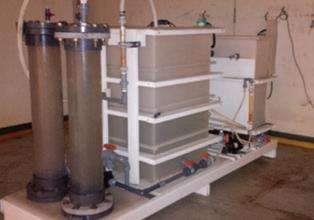
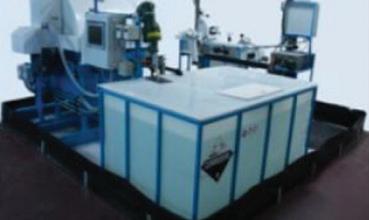
Battery Rescue Australia
A safer way to collect and recycle
Battery Rescue Australia provides an environmentally friendly, safer and more convenient method for storing and transporting used batteries called the Battery Transport & Storage container that was entered for the award in 2019.
The company was established as a demonstration battery collection business by its sister company Uniseg Products, using a BTS container developed by Uniseg as a safer, more environmentally sustainable and efficient method of storing and transporting used lead acid batteries destined for recycling.
The product was developed by inventor, entrepreneur and managing director Fenton Goddard, who noticed when helping a friend in his recycling business that the transport and storage of used lead acid batteries was neither safe nor
“The containers provide an environmentally superior, safer and more convenient method for storing and transporting their used batteries,” says the firm. “The use of battery-powered 4G IoT technology has enabled us to overcome many of the transport challenges to large mine sites in remote areas.”
Bush says many mining companies such as BHP are seeking a safer, regulation-compliant solution for the onsite storage and transport of used lead acid batteries, while also reducing their environmental impact.
The product offers benefits including better safety loading and transport; improved environmental outcomes by eliminating acid leaks (containing high lead levels); more convenient and efficient stacking of batteries; regulation compliance and reduced legal risks; and improved battery recycling rates from remote mine sites.
Black Diamond Structures
Opening the battery world up to nanotechnology
Black Diamond Structures received an honourable mention in the 2016 category bringing the advantages of the world of nanotechnology to a wider audience.
Black Diamond Structures is the commercialization vehicle for Molecular Rebar, a nanotechnology, based on a patented form of the discrete carbon nanotube, that offers a variety of improvements to the lead acid battery industry.
The first, says the firm, is a dramatically improved cycle life — with increases of over 50% in cycling. Charge acceptance is also improved by around a quarter and there are also benefits of greater performance in cold temperatures as well as strong resistance to physical and thermal abuse.
Molecular Rebar can be easily incorporated into the existing manufacturing process — with no additional capital costs or modifications to production processes.
In recent years, lead acid battery developers have used activated carbon, graphite and hybrid lead carbon electrodes to accommodate higher rates of charge and PSoC operation. These additives show promising results, but frequently require significant alterations to existing production lines and paste-mixing recipes. Determining the optimum carbon composition and implementing the new additions have been challenging.
Furthermore, carbon additives present a host of problems: many contain high concentrations of metallic impurities, which can lead to severe side reactions. Their presence in raw materials destined for use in lead acid batteries is therefore strictly regulated. Carbon additives also alter paste rheology, requiring downstream process changes to accommodate the mix.
The Molecular Rebar technology delivers advanced technological solutions at an industrial scale with a minimum of disruption to production.
“When we first started thinking about adding Molecular Rebar to batteries, we understood that the processes of mixing, pasting and curing are well established and have been optimized over decades in the industry,” says a Molecular Rebar Design and Black Diamond Structures spokesperson.
“We challenged our team to ensure that our product could be incorporated into existing processes without disruption or additional optimization of the manufacturing process.”
Black Diamond Structures and Molecular Rebar design, disentangle and functionalize stock carbon nanotubes, making the surface of the tubes compatible with the lead acid battery operating environment, and opening the ends of the tubes.
The process also cleans the carbon nanotubes to reduce the residual catalyst content.
To prepare for use in lead acid battery pastes, the tubes are uniformly dispersed in an aqueous solution. The final product is a pourable liquid which can be introduced directly into the paste mixing process.
The addition of this product to the negative active material improves charge acceptance and extends lifetime under lab-based cycling protocols and in real-world field trials. These tubes in the positive plates enhance the durability of plates subjected to charge/ discharge cycling still further.
“Black Diamond Structures has collected significant performance data from industrially produced 12V batteries at its own testing facilities, at customer sites and at third-party testing facilities.
“The data show reductions in charge times of 25%-75% under constantvoltage conditions and increased cycle life of 25%-300%, depending upon the protocol. Pasting trials have shown that Molecular Rebar can reduce waste and improve production quality,” said one of the principal team members engaged in the project.
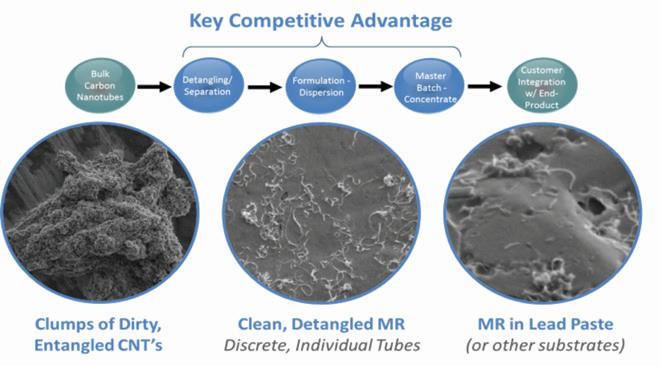
Finding competitive advantage in the process change
Daramic
A portfolio of inventiveness
Daramic, the international separator giant, has advanced separate developments in its technology portfolio.
In 2019, the last year of the innovation awards, Daramic and Huff Technologies developed a way of better simulating how batteries perform in the real world by showing how they move around during everyday use.
The Daramic Shuttle Table was designed to mimic real-world scenarios during testing. It was developed because the companies acknowledged that in all types of environments, vehicles and the lead acid batteries they use are constantly moving.
Together, they have developed a proprietary testing method along with innovative new machinery to allow battery manufacturers to test their products in a real-life scenario.
The technology is able to test up to 12 group 31/L3 batteries simultaneously and the user can select a variety of different programmes offering different types of movements and cycles.
Continued on page 50
Daramic: Continued from page 49
The system allows for a direct comparison between batteries based on different working patterns and battery environments.
Data are collected via an external drive and transferred using USB ports on the machine. A versatile t-slotted rail system allows for quick and adjustable tie down of batteries of multiple configurations and sizes.
The year before, the firm showcased its latest product using carbon coated separator technology. This reduces sulfation crystal growth, delivering a more active surface area on the plates for improved conductance of the electrode. This received an honourable mention.
“Carbon applied directly to the separator, using a proprietary method, while being in contact with the negative active materials shows increased dynamic change acceptance at the cell and battery levels versus standard separators,” said Daramic at the time.
“This has been proven to slow the growth of lead sulfate crystals, which otherwise tend to grow more rapidly in batteries continuously operating in partial states of charge.
“This is part of the Daramic EFB solution roadmap, to support this new battery working pattern.”
In 2017, using advanced computational fluid dynamics, Daramic developed two new separator solutions — Daramic EFS and Daramic RipTide.
Daramic EFS is specifically designed to support start-stop vehicle batteries by reducing the battery’s internal resistance and improving voltage drop and CCA.
Daramic RipTide combines the latest innovations of Daramic with novel separator profile designs using advanced computational fluid dynamics computer modelling to enhance EFB durability by reducing acid stratification in a partial state of charge environment, which is more typical in start-stop applications.
Daramic’s first entry to the BCI Innovation Awards in 2016 was for a product innovation invented three years ago with research continuing on further refinements.
Called DuraLife, this helps protect and maintain the quality and performance in battery designs that use less lead content — a technique that many battery producers have adopted as a way of reducing the overall cost of their products.
DuraLife is a new, high performance polyethylene battery separator. Its design improves battery performance, improves efficiency and yield during battery assembly and, most importantly, compensates for lack of performance or lifespan in battery designs where manufacturers are looking to reduce the amount of lead.

2018: Carbon Coated Separator Technology
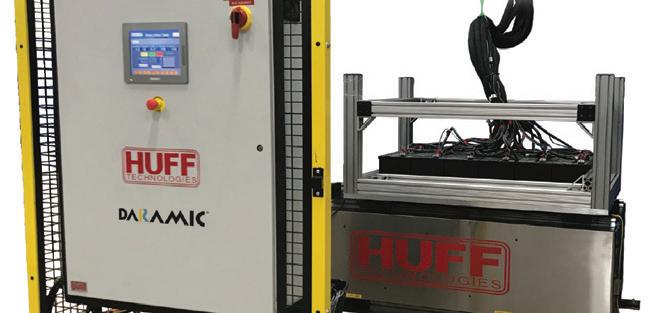
2019: The Daramic Shuttle Table was designed to mimic real world scenarios during testing
Digatron
Battery testing’s next leap forward: rethinking switch mode technology
Digatron Power Electronics approached the innovation award in 2016 with a different angle — looking to reinvent the battery testing system from scratch with what it calls the world’s first laboratory test system with siliconcarbide technology.
“Points of departure from the norm,” said the firm, “were customer demands with regard to energy efficiency, construction size, circuit density, ergonomics, power and dynamic envelope, as well as the latest semiconductor technology derived from military and aeronautics: Silicon Carbide (SiC) MOSFETs.”
Digatron introduced battery testers with active frontends and output amplifiers in SiC-technology in their Repoweren UBT (20V) and MCT (6V) lines. These systems provide up to six 1.8kW test circuits in one 4U (178mm) rack module.
This is equivalent to an almost 10-fold increase of power density compared to any previous designs.
“Our Biconditional Energy Supply Tracking (BEST) system ensures optimum energy efficiency under any operating condition,” says the firm. “This process automatically balances the energy flows between the six circuits and tracks the energy balance of the DC link accordingly, either to regenerate 100% in the DC realm (and top off from AC as needed), or to feed excess energy back to the three-phase grid.”
The Repoweren units can be cascaded in standard 19 inch rack systems. Test circuits can be paralleled up to several kiloamperes. Extra expenses for climatization or acoustic insulation are unnecessary.
EnerSys, MAC Engineering
Further bold moves to remove lead from the air
Two of the major themes of the 2015 BCI conference — the need for tighter environmental rules and greater health regulation — were picked up by EnerSys and MAC Engineering in the following year’s innovation award nominations.
One BCI conference panel session in particular stood out. It was called “Let’s Get the Lead Out: Designing Lead Emission Out of the Manufacturing Process” and was chaired by EnerSys.
The panellists — a mix of battery manufacturers and machine suppliers — consisted of representatives from Johnson Controls, East Penn, MAC Engineering, BM Rosendahl and Sovema. They talked about the challenges faced by manufacturers and the potential problems manufacturers, suppliers and producers would have to overcome if these restrictions become more and more stringent and therefore more and more unmanageable.
Following the BCI meetings there was a flurry of ideas and meetings between EnerSys and MAC. The initial proposal aimed at improving the pasting line — possibly the hardest point to contain lead in the manufacturing process — which immediately looked an early winner.
This involved looking at pasting, flash drying, stacking and the palletizing of plates. If lead and dust could be kept cleaner in this area, both companies believed it would greatly reduce lead in air in the rest of the plant.
Keep the paste where it belongs and nowhere else, was the idea.
“Perhaps the most important underlying idea was that if we could come up with good ideas for taking this forward the knowledge would not belong to us as a machinery manufacturer or EnerSys as a battery maker but it would be open to the whole industry,” MAC Engineering said.
Part of the process was a dis-assembling of the existing health and safety precautions such as cages and guards to protect the employee before assembling them again with the changes.
This involved designing modifications, closing off any unnecessary openings, using sealed conveyors to transport flaked off paste to sealed drums, extending guards, eliminating places where lead dust can gather, creating more efficient ventilation ports, and leaving as little space as possible for any lead to collect.
Because manufacturing lines vary from plant to plant, the thinking was that generic solutions needed to be found — approaches that could be transferred across the industry.
EnerSys and MAC said: “We have developed numerous pragmatic and effective measures to reduce lead emissions into the environment, and therefore a genuine hope that the entire battery industry can be a more productive and environmentally safer place in the future.”
Mark Thorsby, then executive vice president at BCI, was positive about the move.
“This is a great example of the industry as a whole working together to forge a way ahead,” he said. “What’s particularly impressive is that it started with a couple of individuals being fired up at BCI and taking it from there — this wasn’t about a series of high level meetings to decide to get things done nor was it about making someone richer on the basis of this, It was quite simply working out ways for the industry to get lead out of the air.”
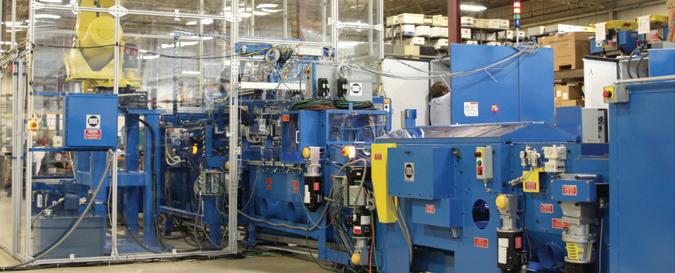
Glatfelter
How a composite scrim laminate can extend EFB cycle life
The development and use of enhanced flooded batteries in stop-start systems is progressing at rapid pace. One of the key improvements required to make EFB viable is increased cycle life, particularly of the positive plate.
One of the promising routes is to apply a scrim material to the surface of the plate to reduce the degradation rate of the positive active material during cycling.
This makes it possible for one product to play two crucial roles: as pasting paper during the production on the pasting line, and then as a retainer scrim, significantly increasing battery cycle life once in operation.
Glatfelter has developed a unique composite scrim Dynagrid NG328 that performs both these functions. The product is a composite laminate made up of two layers, one layer of cellulose fibres adjacent to a layer of polyester (PET) fibres.
The Glatfelter inclined-wire paper making technology ensures a laminated product with a perfect interface between the two layers of the above mentioned cellulose and PET.
Independent analysis showed, among other things, that the Dynagrid NG328 scrim (PET based) increased the DOD 50% cycle life at 40°C by more than 40%. This increase is comparable with glass scrim: Dynagrid NG328 gave an increase of 43%, glass scrim 44%.
The Dynagrid NG328 scrim reduces the rate of deterioration of electrical properties during discharge-charge cycling.
This results in better C20 capacity retention, improved cold start properties and lower increase of internal resistance during cycling. In all of these properties the effect of Dynagrid NG 328 was moderately superior to glass scrim.
GNB Exide
A breakthrough for tough, industrial batteries
GNB Industrial Power, part of what was then known as Exide Technologies, applied for the BCI Innovation Award on the basis of a new battery that came in two forms: TENSOR is a unique high performance battery and TENSOR xGEL an innovative maintenance-free battery.
GNB Industrial Power said the innovative design of this traction battery technology shifts the performance of batteries of this type to a completely new level: “It has more power, is faster at recharging and has a higher efficiency than traditional batteries; meanwhile the gel variant is also maintenance-free.”
The TENSOR batteries combine high performance and maximum uptime with long service life and high energy savings. These batteries are designed for all demanding applications in tough industrial environments and allow fast charging, the company says.
The TENSOR battery will fully charge in four hours, is capable of intermediate and opportunity charging, can last up to 50% longer than standard batteries in cold environments and performs well at very low temperatures.
This makes them ideal for heavyduty trucks, especially those that are operated outdoors throughout the year.
The TENSOR xGEL represents a “fusion between high performance TENSOR technology and maintenance free gel technology”.
Research on this project was kick-started by attempts to find solutions to some of the challenges faced by batteries operating in tough industrial environments where charge times could be too short and traditional batteries struggled in extreme temperatures and also required regular maintenance. HighWater Innovations applied for the BCI Innovation Award for the second time in 2018 on the basis that it had developed its invention ‘the GO Battery’.
This is a low-aspect ratio, spiral wound battery, which is designed for maximum power and life. It is specifically intended for use in hybrid electric vehicles at a fraction of the cost of current battery technologies such as nickel and lithium chemistries.
GO Battery — it stands for Geometrically Optimized — had achieved some 1,000W/kg in power performance by then with a clear development path to more than 1,400W/kg. A conventional lead acid battery delivers some 350W/kg; lithium-ion is now around 1,400W/ kg (but more expensive); the GO Battery is already at 1,000W/kg and improving.
“We are close to achieving three times the power of conventional VRLA batteries,” HighWater says. “We are now approaching what is delivered by lithium-ion batteries but at a fraction of the cost. At around $100 per kilowatt hour, we are in a similar price range to any lead acid battery — and that is a tenth of the cost of a lithium-ion product.”
The GO cell features a low aspect ratio spiral-wound construction with a stackable pack design. This single cell building block can be used to assemble high voltage batteries of any voltage and offers a wide range of form and fitment to the vehicle designer.
The cells are also designed to stack and interlock to form a compact, air-cooled battery pack. The end cells in the pack will be thermally insulated so that all cells will be thermally matched and will therefore operate at the same temperature.
The HighWater founders say the battery will produce more power and have an extended operating life compared with other VRLA batteries. Their low aspect ratio grids will increase the overall power capabilities in the HEV application. Meanwhile, its open central core is designed for improved thermal management.
HighWater Innovations
Tripling power performance through better design
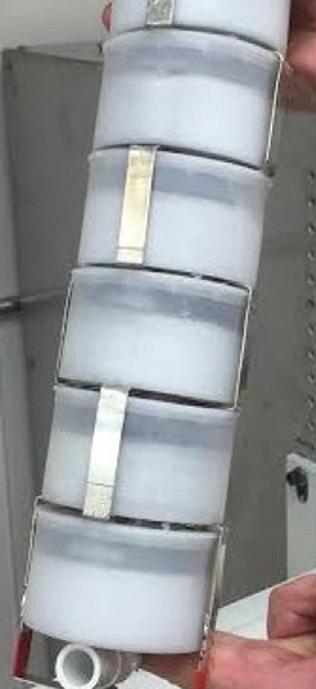
The GO battery is a series of cylindrical two-volt cells with four instead of two current take-off tabs, and a hole in the centre of the cell, through which air can pass. These two-volt cells can be stacked to form strings of any voltage.

Microporous
Booster mat for increased DCA
Separator product developer Microporous has come up with a dynamic charge acceptance booster for lead batteries that works without changing the negative active material. The firm received an honourable mention in the 2019 innovation awards.
The DCA Booster Mat can be bundled with its SLI or industrial separators and is suitable for the growing enhanced flooded battery market. It allows charge acceptance optimization and is suited to High Rate Partial State of Charge requirements for start-stop applications.
The firm says this separator component offers excellent charge acceptance in industrial markets such as motive power, where opportunity charging is required.
The Booster Mat fits tightly against the negative plate surface to add a powerful three-dimensional buffer layer that shuttles charge to and from the NAM. Initial testing demonstrated a 300% improvement in DCA over the control.
Microporous has for years explored ways in which carbon could improve lead acid battery performance and tried to solve some of the problems previous studies had encountered.
“We put our concept to work in 2018,” the firm says. “We saw the need for improved DCA in lead batteries and the imminent threat of Li-ion in start-stop vehicles. Previous studies have shown that mixing carbon into the NAM has its drawbacks and we looked for a better solution.
“The work had four main aims: to improve the DCA in batteries; to do this without negatively affecting cold cranking amps; to do this with minimal impact on water consumption; and to eliminate the need for special NAM formulations.
Improved DCA allows for more efficient opportunity charging, which reduces undercharging and increases cycle life. For EFB battery design, improved DCA removes the phenomenon of battery walk down, which is often seen in automotive batteries used in start-stop operations. Narada has partnered energy storage operator Upside Group in an innovative frequency regulation project, which represents the first large-scale application of lead carbon batteries in grid-level frequency regulation energy storage systems. This project was given an honourable mention in the 2019 BCI awards.
The frequency regulation project was for the German power grid and the installation, at Langenreichenbach, has a planned construction capacity of 75MW. The installed capacity of the first phase of the project is 16.4MW, and the peak energy storage capacity can reach 25MWh. This project consists of 18 containers, and the battery consists of 10,584 units of 1200Ah lead carbon valve regulated cells. It is powered by nine inverters, each of which can provide 1.8 MVA.
Narada was one of the pioneers in terms of developing lead carbon battery energy storage systems in energy storage.
It says it elected to do this project in Germany because the utilization of renewable energy in the country is one of the most advanced in the world. Its power grid frequency regulation market is thus a mature power market auxiliary service trading market. The company says its entry to the German energy storage market marks the beginning of Narada’s entry to the global market.
The project was driven by the Narada Project Development Team, which was responsible for the finance and development of the entire project. It says it believes that the application of lead carbon batteries in energy storage systems is groundbreaking.
“This project is the first large-scale application of lead carbon batteries in grid-level frequency regulation energy storage systems, and is of exemplary significance worldwide,” the company said. “In mitigating the power consumption of the local power grid, it adjusts grid balance, saves energy and reduces carbon dioxide emissions. And it provides electricity for local residents.”
The company said the project will help Narada better understand this sector. It now wants to be heavily involved in the storage market of frequency regulation to promote energy storage systems throughout Germany and then Europe.

Narada
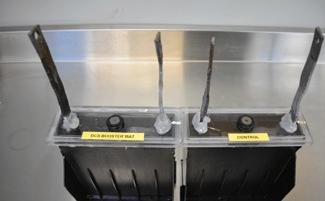
A new approach to grid-level frequency regulation

Philadelphia Scientific
Doubling the capacity of battery charging rooms
Philadelphia Scientific has developed a ‘charger splitter’ capable of doubling the capacity of a typical battery room, offering a much better return on investment in the process.
Philadelphia Scientific’s iBOS Charger-Splitter is used in tandem with the iBOS [Intelligent Battery Organizing System] battery room management system, effectively using one charger to charge multiple batteries, and increasing the charging capacity of a battery room.
The Charger-Splitters are installed on conventional battery charging systems and when a battery is charged, a flashing LED alerts operators to disconnect it and plug it in to an uncharged battery. This enables the sequential charging of two batteries with one charger.
One of the biggest investments in a battery room is the cost of the chargers. They are an essential piece of equipment but are only used an average of 22% of the time.
The iBOS Charger-Splitter makes it possible to utilize unused charger capacity and halve the number of chargers needed to charge a battery fleet.
The company estimates that for sites with 20 chargers or more, it will more than pay for the entire iBOS system with money left over.
Alerts are displayed on the remote operations display to ensure the switch gets done and reports on the iBOSWorld website track user performance using the system.
In some cases, Charger-Splitters will enable battery room managers to reduce the number of chargers used by a third to a half, the company estimates. For the average battery room, that’s an annual saving of tens of thousands of dollars.
It estimates that warehouses and DCs that are planning a new battery room can achieve 50% savings on charger purchases because they will require only one charger for every two batteries, not one charger per battery.
For battery rooms that must increase capacity by purchasing more batteries or trucks, half the number of chargers will be required than if Charger-Splitters are not being used. Charger-Splitters also provide an ideal solution when managers do not want to install costly extra power infrastructure to support additional chargers in a battery changing area.
iBOS 2 — Battery Management System (below). Philadelphia Scientific charger-splitter (right) Power Sonic

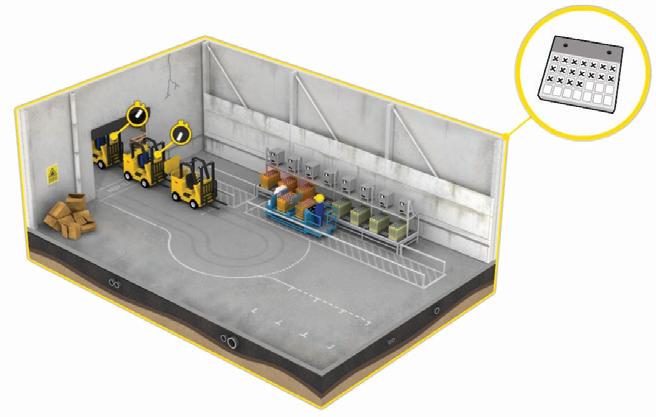
The joys of smart grid management
Power Sonic’s DRM (demand response module) is an innovative energy storage system suitable for the smart management of medium and high voltage electrical grids. It was nominated for the innovation award in 2019.
The firm said: “Our DRM system enables fast response times to variations in demand and supply, helping maintain grid stability and ensuring reliable, high-quality energy supply response through a range of applications.
“Based on current demand side response markets the DRM would pay for itself after four years. This is down to the speed in which it can respond to demand signals from the grid. With different financial models available including leasing and the ability to generate revenue from day one tied into long-term contracts with the grid, the DRM doesn’t just offer an innovative solution for energy storage but also a great investment as a stand-alone asset.
“Power-Sonic is capable of managing the energy to meet all demands according to the requirements set by the utility provider.”
The applications supported by the system include emergency backup in the event of a power interruption; with micro grids, a localized grid that can operate independently; renewable energy, the system facilitating seamless integration with renewable power generation sources; and reserve capacity, the DRM system providing power and energy capacity to the power grid as a stand-alone asset.
Other challenges it can address include peak shaving, frequency regulation, load levelling, renewables capacity firming and power quality, resulting in less energy consumption, more grid resilience, better power quality, monetary savings and income generation. The company says it can stabilize the grid to manage the consumption and production of renewable energy.
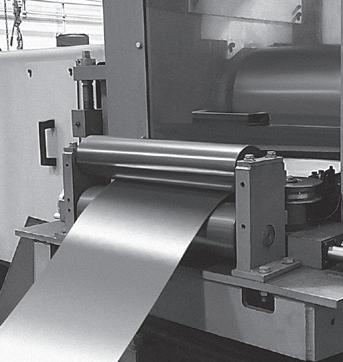
The as-cast strip thickness can be varied simply by changing the feed nozzle and adjusting the casting roller positions to produce as-cast thicknesses between about 0.200 inch (5.0mm) and 0.470 inch (12.0mm). Our rolling mills can also make minor adjustments to the fi nal rolled thickness “On the Fly” during operation so the Wirtz strip casting system produces the highest quality strip in the most fl exible system.
our new strip caster technology raises the bar on strip quality
The Wirtz strip caster is production ready and produces the highest quality dross free strip. A patent pending, completely enclosed lead delivery system is the key to our high quality strip. Our completely enclosed lead delivery system delivers molten lead from the furnace into our patent pending feed nozzle without any exposure to the atmosphere. The lead feed nozzle distributes lead to the casting wheels without any turbulence for consistent grain sized, dross and impurity free high quality strip. There is no dross generated anywhere in the process. The caster is easily started, runs automatically with little-tono operator intervention, and can be stopped and restarted very easily during production runs. It was designed to take very little floor space. We understand grid and plate making. We developed and patented the grid surface “Reforming and Texturizing” to improve paste adhesion to the highly corrosion resistant wrought strip punched grid. Our steel belt pasting developments revolutionized plate making by holding exacting tolerances at high pasting speeds, and our patented “On the Fly Thickness Control” gives operators the ability to adjust plate thickness to be during operation. Call Wirtz to produce the highest quality strip and punched grids and pasted plates in the world at +1 810 987 7600 or email us at sales@wirtzusa.com.
INNOVATION. PERFORMANCE. RELIABILITY.
Remy Battery
The return of packaging for dry charged lead acid
Remy Battery applied for the BCI Innovation Award in 2017 on the basis of its FreshStart packaging solution for utility, automotive and commercial dry charged lead acid batteries.
The company says its solution solves a problem for a useful and age old product — how to activate a dry charged battery with the proper amount of electrolyte.
The firm says there is still a market for dry charged lead-acid batteries, which have significantly longer shelf life than traditional wet lead acid or AGM batteries. These dry charged batteries meet a current niche where a battery may not be put into service within the first three to 12 months of the battery’s production date.
“Increasingly, the challenge for dry charged batteries has been sourcing the battery electrolyte to activate these batteries,” the firm says.
“With increased shipping and environmental regulations over the past decade, securing and storing battery electrolyte has become increasingly difficult for the distributor and consumer.
The FreshStart solution solves this problem by packaging individual limited required cell volumes of electrolyte in high density polypropylene containers with the dry charged battery.”
By packaging individual cell quantities of electrolyte it solves the problem of the consumer having to search locally for a source for electrolyte and also provides the exact amount of electrolyte needed for each cell, no overfilling or under filling of cells, which will help extend the life of the battery once activated.
The background for this work was the result of a US government contract, which Remy Battery was awarded, which required the development of a larger dry charged commercial battery where each individual dry charged battery had to be shipped with the exact amount of electrolyte in a secure, durable performance shipping container.

Terrapure
Solving lithium ion dangers in the recycling process
Terrapure has developed a product to detect and remove lithiumion batteries from the lead recycling stream, an innovation that has important implications for the sector given the significant safety risks posed by lithium-ion batteries mistakenly ending up in the lead recycling process. It was nominated for the BCI award in 2019 and 2018.
Called the Li-ion detector, or LI Detector, it uses high-frequency radio waves to detect lithium batteries by scanning for their unique charging and protection circuitry. If detected, they can be easily removed by hand or automatically.
More than one million tonnes of lead acid batteries are recycled every year in North America alone. One of the early steps in the process is battery breaking, which involves disintegrating the batteries mechanically so the acid can drain out.
This is normally a reliable and safe process; however, problems can occur when batteries other than LABs accidentally enter the process. The biggest risk is from lithium-ion batteries. Upon entering the breaking process,
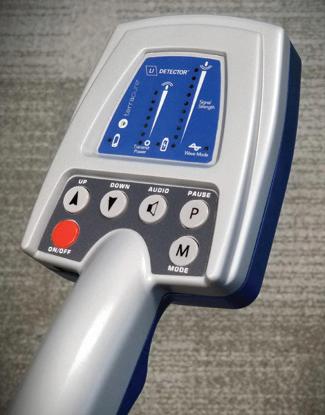
Terrapure LI detector
they can explode in contact with the acid, causing damage to equipment and exposing plant personnel to potential harm.
Separating LIBs from LABs is a challenging task as they often look identical or very similar. BCI has been at the forefront of campaigning for standard packaging detailing which batteries are which.
“The LAB recycling industry has proposed several ideas to identify LIBs but all require tagging or colour coding LIBs at their point of manufacture. Getting all LIB makers around the world to agree to modify their designs at additional cost will be difficult if not impossible. In addition, none of these solutions applies to the countless LIBs already in use,” he says.
Work on the LI Detector started in 2017 with the first commercial tests happening in September 2018. Terrapure has several handheld functioning prototypes.
“This is a huge safety advance for the industry with the capability to protect people as well as equipment from explosions and fires,” the firm says.
UK Powertech
Improving battery formation through better connectivity
UK PowerTech applied for the BCI Innovation Award in 2018 on the basis of both design and an improvement to the manufacturing process for batteries.
Increasingly, battery makers have been pushing the limits in terms of how quickly they can charge a battery post manufacturing. Formation times have dropped from 24 to six hours for SLI batteries due to advances in formation cooling technology, acid recirculation and switch-mode pulsing rectifiers.
But the resulting fourfold increase in charging currents has exposed an inherent weakness in the connections between the batteries in the formation circuits. This is the high resistance interface between the connector head and the battery terminal.
This resistance has several causes including a barrier layer on the connector head surface resulting from the hostile environment of the formation department; a reduced contact area from poorly fitted connectors due to the difficulty of making and then removing around 3,000 connectors per man in a single shift; heat generated during formation from high resistance joints; and connector damage due to battery terminals being occasionally incorrectly manufactured, plus electrical arcing from damaged or loose connectors.
Since average SLI formation currents have increased from 15 to 60+ amps, the damage to batteries and the likelihood of formation room fires has increased.
UK PowerTech developed a blueprint for changes to working practices to ensure that connectors are fitted correctly and maintained and cleaned better. The firm also developed a new type of connector. The UK Powertech P type connector is designed to alleviate all of the problems with the standard design. The design uses a split spring design head, which will mould around the battery terminal even if placed unevenly.
This design does not provide a resistance fit as typified by standard push fit connectors. It is easily removed by an operator, and there is no incentive to loosely fit connectors.
Uniseg Products
Better ULAB transportation for safer, more efficient recycling
UNISEG Products applied for the BCI Innovation Award in 2018 on the basis of its Battery Transport & Storage (BTS) container, which brings many benefits to the recycling process including better safety, increased efficiency, better compliancy and improved data transparency on what has been collected and when.
The technology will reduce the amount of battery acid leaking into the environment, improve public safety, eliminate unnecessary double handling of batteries, protect workers from being exposed to acid burns and lead contamination — and also save money.
The BTS container allows the batteries to be ergonomically loaded into a pallet while the rear, left and right hand panels help keep the batteries in place. When the container is full of batteries it can be closed and secured.
One fundamental difference of the BTS container as a replacement for a conventional wooden pallet is that it entails operating a closed loop container pool. After the containers are emptied at the reprocessing plants, they are collapsed and returned.
An independent costing by Fleetrak Consulting demonstrated that despite the additional costs of washing and returning the BTS containers, on average there is a saving of A$21 ($16) per tonne of batteries transported.
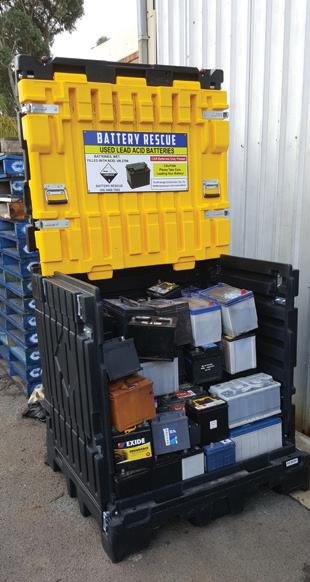
The BTS container allows the batteries to be ergonomically loaded into a pallet while the rear, left and right hand panels help keep the batteries in place. When the container is full of batteries it can be closed and secured.
Voltific
VOLTiFiC Technology applied for the innovation award in 2019, having developed a universal battery sizing software that allows for the faster, more efficient and more accurate sizing of batteries. It can also be accessed through the internet.
The VOLTiFiC cloud platform is designed to allow anyone to size or service industrial batteries regardless of technology, manufacturer, chemistry or application.
A typical battery sizing software from a manufacturer can produce between five and 20 battery system designs within 20% of the requirements,” says the firm.
“Compare that to hundreds of solutions that VOLTiFiC can generate within 5% of the requirements. The software adheres to international battery standards and allows for deep analysis of battery performance.”





